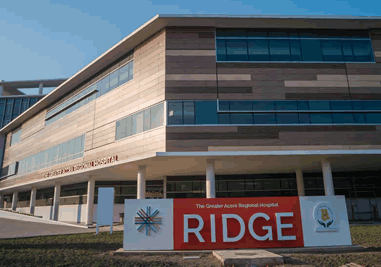New Greater Accra Regional Hospital opens to public
 The first phase of the New Greater Accra Regional Hospital at Ridge was on Wednesday opened for public use with an expanded bed capacity from 192 to 420.
The first phase of the New Greater Accra Regional Hospital at Ridge was on Wednesday opened for public use with an expanded bed capacity from 192 to 420.
The ultra-modern facility, which was constructed with a credit facility from the United States (US) Exim and the HSBC banks, is envisaged to provide expanded access and quality healthcare to over six million people across its catchment area and the entire country.
It has a comprehensive Diagnostic and Treatment Block, providing a 24-hour surgery, an Imaging Department, Delivery Unit, Accident and Emergency, Neonatal Intensive Care Unit (NICU), Intensive Care Unit (ICU), an Emergency ICU, Burns, as well as a Delivery High Dependency Unit (HDU).
It also houses the Pharmacy, Laboratory, Central Sterilisation, Kitchen, Laundry, Workshop, Central Stores, Technical Rooms, Crèche and changing rooms.
Mr Kwaku Agyeman-Manu, the Minister of Health, thanked the contractors for completing the project on schedule and expressed gratitude to the US and French governments for their sustained assistance.
He commended the previous administration of the National Democratic Congress (NDC) for initiating the project which would go a long way to address the healthcare challenges of the region.
Mr Agyeman-Manu said the Government, in the spirit of continuity, would remain committed to initiating a vigorous search for funding for the commencement of the second phase of the project, which targeted an additional 200-bed, bringing the total number to 620.
He, however, called on the Management of the Hospital and clients who would access the facility to observe a high maintenance culture, saying; “with the right kind of attitude and leadership, we can optimise the use of this edifice and ensure that it lasts long for posterity”.
Dr Anthony Nsiah-Asare, the Director-General of the Ghana Health Service, said the facility, which used to be bedevilled by numerous challenges including the lack of beds and congestion at the wards and operating areas, now had enough room to accommodate clients and ease the frustrations on staff and patients to ensure high quality services.
He said the facility could now boast of the full complement of expertise services and could contribute to the training of doctors and other specialists for the nation.
“It was envisaged that the first phase of the reconstruction play a key role in the efforts to especially improve maternal, neonatal and child healthcare services and enhance an effective continuum of care in the capital city and the nation as a whole,” he said.
Mr Robert Jackson, the United States Ambassador to Ghana, expressed gratitude to the Government for the opportunity and partnership that had further strengthened the bilateral relationship existing between the two countries over the years.
He said the New Greater Accra Regional Hospital was the first in Africa to be granted the Leadership in Energy and Environmental Designed Certification, which was an internationally recognised green building certification system.
Mr Jackson said this provided third-party verification that a building or community was designed and built for using strategies aimed at improving performance across all the metrics that matter most.
This includes energy savings, water efficiency, carbon dioxide emissions reduction, improved indoor environmental quality, stewardship of resources and sensitivity to their impacts.
Mr Jackson said there was also ample evidence that with committed efforts, countries could easily mobilise large amount of local and private resources to resolve their health challenges.
Mr Ismael Ashittey, the Greater Accra Regional Minister, commended the Ministry of Health and its partners for delivering on their mandate and challenged the Management of the facility to maintain high quality standards in healthcare and professionalism.
He, however, advised the public to be proactive in ensuring that their environments were kept clean, insisting that preventive care is much cheaper than curative, therefore increasing the health infrastructure must go with improved public education to reduce the current disease burden in the region.
Source: GNA
